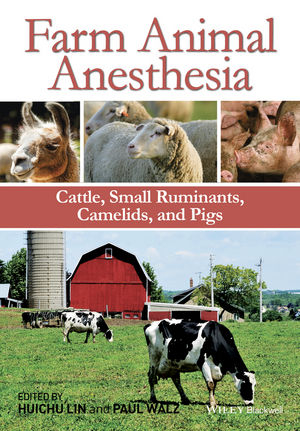
Farm Animal Anesthesia
John Wiley & Sons Inc (Verlag)
978-1-118-47435-8 (ISBN)
- Titel ist leider vergriffen;
keine Neuauflage - Artikel merken
Providing thorough information on pain management and residues, the book also covers specific techniques for common surgical procedures and considerations for animals with pathophysiological conditions. The book includes chapters on preanesthetic considerations, anesthetic drugs, chemical restraint and standing sedation, injectable anesthesia, inhalant anesthesia, local techniques, specific procedures, pain management, residues, and euthanasia. Farm Animal Anesthesia is a useful guide for farm animal practitioners, veterinary students, and researchers working with these species.
- Offers complete coverage of practical uses for anesthetics and analgesics in cattle, small ruminants, camelids, and pigs
- Brings information on sedation and pain management in these species together into a single resource
- Presents difficult-to-find information on anesthetizing camelids and pigs
- Includes information on pain management and residues
- Provides a comprehensive reference for farm animal practitioners, veterinary students, and researchers
HuiChu Lin , DVM, MS, DACVAA, is a Professor of Anesthesia at the College of Veterinary Medicine at Auburn University in Auburn, Alabama, USA.
Paul Walz , DVM, MS, PhD, DACVIM, is an Associate Professor of Food Animal Medicine at the College of Veterinary Medicine at Auburn University in Auburn, Alabama, USA.
Contributing authors xii
Preface xiii
1 Preanesthetic considerations 1
HuiChu Lin
Positioning 2
Ruminal tympany 3
Regurgitation 3
Salivation 4
Malignant hyperthermia 6
Differences in sensitivity to anesthetics 6
Preanesthetic preparation 8
References 13
2 Commonly used preanesthetics 17
HuiChu Lin
Acepromazine (phenothiazine derivatives) 18
Cattle 18
Small ruminants and camelids 19
Swine 19
Droperidol and azaperone (butyrophenone derivatives) 19
Detomidine, medetomidine, romifidine, and xylazine (α2 agonists) 20
Cattle 21
Small ruminants and camelids 24
Swine 27
Atipamezole, tolazoline, and yohimbine (α2 antagonists) 28
Diazepam and midazolam
(benzodiazepine derivatives) 29
Cattle, small ruminants, and camelids 30
Swine 30
Chloral hydrate 31
References 31
3 Standing sedation and chemical restraint 39
HuiChu Lin
Cattle 39
Small ruminants and camelids 42
Swine 48
References 57
4 Injectable anesthetics and field anesthesia 60
HuiChu Lin
Injectable anesthetics 61
Ketamine 61
Telazol 64
Propofol 66
Guaifenesin 68
Field anesthesia 68
Cattle 68
Small ruminants and camelids 72
Swine 80
References 87
5 Inhalation anesthesia 95
HuiChu Lin
Cattle 101
Small ruminants and camelids 103
Swine 104
References 106
6 Perioperative monitoring and management of complications 111
HuiChu Lin
Perioperative monitoring 111
Supportive fluid therapy 116
Positioning 121
Recovery 123
Perioperative complications 123
Regurgitation and aspiration pneumonia 123
Airway obstruction 124
Ruminal tympany/bloat 125
Salivation 126
Hypoventilation 126
Cardiac arrhythmias 127
Hypotension 128
Hypothermia 129
Malignant hyperthermia 130
Postanesthetic neuromyopathy 131
Cardiovascular collapse 131
References 132
7 Local and regional anesthetic techniques 136
Misty A. Edmondson
Local anesthetics 136
Anesthesia for dehorning 137
Nasal anesthesia 137
Anesthesia of the eye 139
Eyelid 139
Eye and orbit 139
Anesthesia for laparotomy 141
Proximal paravertebral nerve block 141
Distal paravertebral nerve block 142
Inverted-L block 142
Line block 143
Anesthesia for reproductive procedures 144
Caudal epidural anesthesia 144
Continuous caudal epidural anesthesia 146
Lumbosacral epidural anesthesia 147
Sacral paravertebral nerve block 148
Internal pudendal nerve block 149
Dorsal penile nerve block 150
Castration 151
Teat anesthesia 152
Inverted-V block 152
Ring block 152
Infusion of teat cistern 152
Anesthesia of the distal limb 153
References 154
8 Anesthetic management for specific procedures 155
Benjamin Newcomer and Paul Walz
Umbilical hernias 156
Wounds, lumps, bumps, and abscesses 157
Wound management 157
Ocular squamous cell carcinoma 158
Enucleation 158
Entropion 159
Abscess removal 159
Surgical disorders of the abdomen 159
Laparotomy 159
Disorders of the forestomachs 161
Displacements and volvulus of the abomasum 162
Small intestine disorders (intussusception, intestinal volvulus, intestinal obstruction) 162
Urolithiasis and ruptured urinary bladder 163
Urogenital surgery in the female 164
Cesarean section 164
Ovariectomy 165
Vaginal prolapse 166
Perineal laceration 166
Urogenital surgery in the male 166
Castration 166
Penile translocation 168
Persistent frenulum 169
Penile papilloma 169
Epididymectomy 169
Vasectomy 169
Musculoskeletal indications 170
Dehorning 170
Claw amputation 171
Excision of interdigital fibromas 171
Tail docking 171
Rectal prolapse 172
References 172
9 Pain management for farm animals 174
HuiChu Lin
Local anesthetics 177
Systemic pain management 178
Opioid analgesics 178
Nonsteroidal anti-inflammatory drugs 183
Alpha-2 agonists 187
Ketamine 188
Gabapentin 188
Drug combinations for pain management 189
Constant rate infusion 190
Local or regional analgesia 197
Caudal epidural analgesia 197
Lumbosacral epidural anesthesia 198
Intra-articular analgesia 200
References 204
10 Fluid therapy 215
Paul Walz
General considerations 215
Physiology of body fluids 216
Patient assessment 218
Fluid and electrolyte therapy in the perioperative period 219
Quantity and rate of fluid administration 220
Fluid type 221
Method of administration 224
Monitoring fluid administration 226
References 227
11 Regulatory and legal considerations of anesthetics and analgesics used in food-producing animals 228
Thomas Passler
Alpha-2 agonists 231
Barbiturates 233
Benzodiazepines 233
Dissociative anesthetics 234
Local anesthetics 235
Opioids 236
Nonsteroidal anti-inflammatory drugs 238
Phenothiazine derivatives 241
Propofol 241
References 243
12 Euthanasia of farm animals 248
Thomas Passler
Considerations prior to euthanasia 248
The process of euthanasia 251
Methods of euthanasia 251
Injectable euthanasia drugs 252
Physical methods 253
Adjunctive and other methods of euthanasia 257
Considerations subsequent to euthanasia 258
References 259
Index 263
| Verlagsort | New York |
|---|---|
| Sprache | englisch |
| Maße | 170 x 244 mm |
| Gewicht | 576 g |
| Einbandart | kartoniert |
| Themenwelt | Veterinärmedizin ► Klinische Fächer ► Anästhesie / Intensivmedizin |
| Veterinärmedizin ► Großtier | |
| ISBN-10 | 1-118-47435-X / 111847435X |
| ISBN-13 | 978-1-118-47435-8 / 9781118474358 |
| Zustand | Neuware |
| Informationen gemäß Produktsicherheitsverordnung (GPSR) | |
| Haben Sie eine Frage zum Produkt? |
aus dem Bereich



